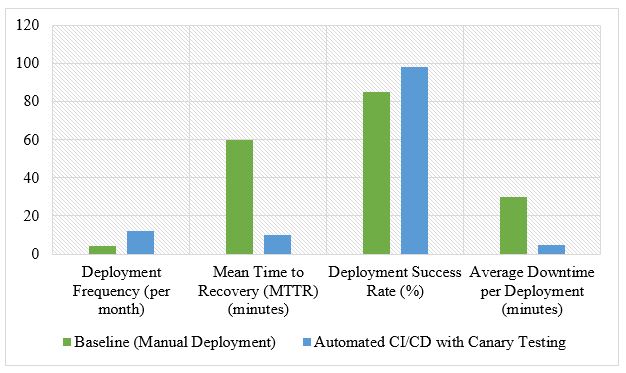Automating Scalable and Secure Enterprise Applications with Full-Stack Java: CI/CD Integration with Canary Testing
DOI:
https://doi.org/10.5281/zenodo.15590008Keywords:
full-stack java, CI/CD, canary testing, enterprise applications, automation, devops, scalability, security, deployment automation, software reliabilityAbstract
Focusing on the integration of Continuous Integration and Continuous Deployment (CI/CD) pipelines with canary testing techniques, this paper investigated the automation of scalable and secure enterprise systems created with full-stack Java. The study looked at changes in deployment frequency, system performance, dependability, and security posture by means of a thorough DevOps architecture. Apart from a notable drop in security vulnerabilities, the results showed notable improvements in deployment efficiency, less downtime, and quicker recovery times. By allowing incremental rollouts and early problem detection, canary testing showed efficacy in risk reduction, hence guaranteeing better system stability. The combination of security automation and compliance and vulnerability monitoring was made even stronger by it. The research confirms that for modern enterprise application delivery, combining CI/CD automation with canary testing is a strong strategy since it balances agility with operational resilience.
Downloads
References
A. G. Sánchez. (2024). Azure OpenAI service for cloud native applications. O'Reilly Media, Inc.
A. M. Ștefan, N. R. Rusu, E. Ovreiu, & M. Ciuc. (2024). Empowering healthcare: A comprehensive guide to implementing a robust medical information system—Components, benefits, objectives, evaluation criteria, and seamless deployment strategies. Applied System Innovation, 7(3), 51.
A. Ostrowski, & P. Gaczkowski. (2021). Software architecture with C++: Design modern systems using effective architecture concepts, design patterns, and techniques with C++ 20. Packt Publishing Ltd.
A. Renuka, & P. K. G. (2024). Pandian, advanced cloud automation workflows for CI/CD pipelines: Tools and Techniques.
D. F. R. Ribeiro. (2024). Engineering the SHIDA super-app research, design and development of a literature-centered social network with E-commerce and E-learning.
E. Salvucci. (2021). MLOps—Standardizing the machine learning workflow.
F. B. U. Team. (2024). Cloud-native application architecture: Microservice development best practice. Springer Nature.
J. Nawagamuwa. (2023). Infrastructure as code frameworks evaluation for serverless applications testing in AWS. Tampere University.
L. Faubel. (2024). An MLOps platform comparison.
L. Van Gerven. (2023). Creation of a cloud-native application: building and operating applications that utilize the benefits of the cloud computing distribution approach. M.S. Thesis, Universidade NOVA de Lisboa, Portugal.
N. Vasavada, & D. Sametriya. (2021). Cracking containers with docker and kubernetes: The definitive guide to docker, kubernetes, and the container ecosystem across cloud and on-premises. BPB Publications.
R. Chandramouli. (2022). Implementation of devsecops for a microservices-based application with service mesh. NIST Special Publication, 800(204C).
R. Wen, & H. Koehnemann. (2022). SAFe® for DevOps practitioners: Implement robust, secure, and scaled agile solutions with the continuous delivery pipeline. Packt Publishing Ltd.
S. S. Sangapu, D. Panyam, & J. Marston. (2022). The definitive guide to modernizing applications on google cloud: The what, why, and how of application modernization on Google Cloud. Packt Publishing Ltd.
Y. Brikman. (2022). Terraform: Up and running: Writing infrastructure as code. O'Reilly Media, Inc.

Published
How to Cite
Issue
Section
ARK
License
Copyright (c) 2025 Ishwar Bansal

This work is licensed under a Creative Commons Attribution 4.0 International License.
Research Articles in 'Applied Science and Engineering Journal for Advanced Research' are Open Access articles published under the Creative Commons CC BY License Creative Commons Attribution 4.0 International License http://creativecommons.org/licenses/by/4.0/. This license allows you to share – copy and redistribute the material in any medium or format. Adapt – remix, transform, and build upon the material for any purpose, even commercially.










